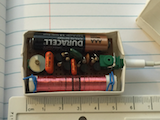| Su | Mo | Tu | We | Th | Fr | Sa |
|---|---|---|---|---|---|---|
| 1 | 2 | |||||
| 3 | 4 | 5 | 6 | 7 | 8 | 9 |
| 10 | 11 | 12 | 13 | 14 | 15 | 16 |
| 17 | 18 | 19 | 20 | 21 | 22 | 23 |
| 24 | 25 | 26 | 27 | 28 | 29 | 30 |
| 31 |

|
Another way to use up batteries...This is a 1.5 volt AAA batter radio that drives a pair of earbuds. It works surprisingly well - it has few controls - in a minimalist quasi high quality high-fidelity Scandinavian audio buff sort of a way (not really). It is quite loud too. It uses about 3ma - so a fresh AAA battery lasts something in the region of 10 days (that is an estimate - I have not checked).
I made this a while ago - inspired by various pictures of matchbox size radios on the web. I made it using a standard tuner circuit and adding a couple of stages of amplification - initially it was a little unstable and prone to oscillate - which often happens with simple radios - but this was cured using a filtering capacitor which removes much of the RF before it gets to the audio amplifying transistors (I learned about this by looking at the pages here - which is also where the basic circuit came from). Thank you Andy Collinson!
The circuit is a little vulnerable to volume fluctuations if you have it in a pocket as you move around (changing the orientation of the direction ferrite antenna). In practice this is not too problematic. I have considered putting in an automatic gain control (AGC) of the types described here and here. Perhaps one day...
One interesting observation about making something like a little am radio is that (of course) I could buy such an item for a small sum of money and likely have a better radio. So I have been puzzling as to why I want to make one. One of the attractions of making something yourself - with relatively vague instructions and objectives - is that you need to solve various problems and make various compromises as you go. So there is an element of enjoying the journey as well as the destination. Well, that is my current excuse...
I will post the circuit soon - it has a few variations relative to the design published by Andy Collinson.

|
I thought I would use a relatively new AA battery to power a flickering Joule Thief to see how its battery voltage varied with time. The image here shows the resulting voltage versus time relationship.
The ACDelco alkaline AA battery was bought a couple of years ago from Fry's Electronics. It was unused initially (if a little old) and ran the Joule Thief for 6.75 days. I must admit that I was disappointed by this performance - I had been expecting more than 7 days. (I am not sure why I expected more, the device draws 38 milliamps from a fresh battery. A typical alkaline AA battery is rated at 2000 milliamp hours, so should only power the device for 2000/38 or approximately 50 hours). Anyway, I was optimisitic, because I figured that as the batteries voltage went down, so the current drain would drop. To some extent this was true, because 6.75 days is much more than 2 days (!) but the Joule Thief did not run down the battery as far as I thought it would in voltage terms. The LEDs stopped flickering somewhere between 0.67 and 0.63 volts, and I had been expecting something more like 0.45 volts.
This particular Joule Thief circuit (as shown here) has voltage stabilization and this is probably costing quite a few wasted milliamps. The coil is also likely not the most efficient - I used a ferite rod rather than a torroidal core. Taking a battery that can hardly light the flickering LEDs in this circuit and using it with a standard Joule Thief shows the expected behavior with the LEDs still being powered down to about 0.48 volts.
You can make semiconductors which operate at lower voltages and so can extract energy from batteries down to very lower voltage. For example, germanium transistors work down to about 0.2 volts and JFETs and CMOS devices even lower voltages I believe.
So this device could be improved, but it does get something extra from with otherwise useless batteries - and I quite like it.